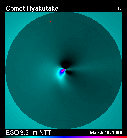Comet Hyakutake - Update (April 4, 1996)
Read More:

Dust Jets (ESO NTT Image)
This is another Update about recent observations of this comet; the latest was published on the ESO Web on April 1 . It is based on information received directly by email and also from IAU Circulars and on other Hyakutake WWW pages.
Richard M. West (ESO)
April 4, 1996; 14:00 UT
X-rays from Comet Hyakutake
It seems that comets are always good for surprises!
The latest is the observation on March 27 with the ROSAT X-ray observatory in Earth orbit of unexpectedly strong X-ray emission from the coma of Comet Hyakutake. A first account of this most surprising discovery has just been published on the Web by the involved team of US and German scientists, including a unique X-ray image of the innermost area around the nucleus.
Nobody had ever expected that a comet would feature X-ray emission at this relatively high level - 100 times more intense than predicted. Except for those which come extremely close to the Sun, comets are comparatively cool objects (in astronomical terms) and the various processes that are observed to take place in the coma do so at relatively moderate temperatures. It has been known for a long time that the strong solar ultraviolet radiation - from which we are ourselves fortunately protected by the ozone layer in the Earth's atmosphere - causes many molecules in the coma to dissociate and some to become ionized (electrically charged). The ions are then influenced by the interplanetary magnetic field and the charged particles in the solar wind. However, a strong emission of highly energetic X-rays is not a natural consequence of our current picture of what is thought to be going on in a cometary coma of gas and dust.
Nevertheless, this observation shows that X-rays are emitted from a crescent-shaped region in 'front' of the cometary nucleus; in projection it is roughly symmetrical around the direction towards the Sun. The X-ray intensity is also variable. There is, as expected, no detectable X-ray emission from the nucleus itself.
The ROSAT scientists propose two different mechanisms which may be responsible for this phenomenon. In the first case, it might be that solar X-rays (mostly from the high-temperature solar 'corona' - the halo around the Sun which is seen during solar eclipses) are absorbed by the molecules (e.g. water) in the coma and re-emitted by a fluorescence effect; this might possibly happen, if the coma is very dense. Another possible explanation is related to violent collisions between the solar wind particles and those in the cometary coma.
A detailed analysis of the ROSAT images may cast more light on this question.
Comet Hyakutake during the lunar eclipse
Many observers in the Northern Hemisphere turned out to watch Comet Hyakutake in a dark sky during the lunar eclipse last night (April 3 - 4). Here in Munich (and in most of southern Germany), the sky was completely clouded over, but in Northern Europe, the viewing conditions were absolutely perfect in many places. For instance, in several regions of Denmark, amateurs were active showing the comet to the public who according to the available reports seemed to thoroughly enjoy the beautiful sight of the comet, now rather low in the sky.
The latest magnitude estimates indicate that the comet's brightness has now stabilized around 2.0 - 2.5. It is expected that this value will not change very much during the next days. Two effects now compensate each other: as the comet recedes from the Earth, it ought to get fainter, but as it also approaches the Sun, the amount of dust in the coma continues to increase, reflecting more sunlight and therefore counteracting the other effect. Nevertheless, the angular extent of the comet's coma and tail, as seen in the sky, will decrease for some time.
Gas and dust production variable
Observations with the International Ultraviolet Explorer (IUE) observatory in orbit around the Earth (IAUC 6370) indicate that the water production from the nucleus reached a temporary maximum at about the time of the closest approach to the Earth (March 25). This effect is believed to be caused by a particularly strong production rate when small pieces broke off the nucleus just before and during these days. In this process, 'fresh' surfaces were exposed to the surrounding space and contributed to the evaporation of gas and dust.
Many infrared molecular emission lines were observed (IAUC 6366) with the NASA Infrared Telescope Facility on Mauna Kea (Hawaii) on March 23 and 24, e.g. H2O (water), HDO (deuterated water), CH3OH (methanol), CO (carbon monoxide) and NH3 (ammonium). Among the new molecules detected was C2H6 (ethane), but emission from C2H2 (acetylene) and HC3N was not recorded.
A more detailed analysis of the motion of some of the observed condensations (gas and dust clouds surrounding small fragments broken off the main nucleus) now shows (IAUC 6367) that one of the fragments, first observed in Italy on March 25 and later by the Hubble Space Telescope, underwent strong brightness fluctuations at the end of March. Its appearance also changed and it reached magnitude 13 on April 1. It moved away from the main nucleus with a velocity of 11.5 m/sec. In all respects, this behaviour is typical of a small fragment whose lifetime is measured in weeks.
Peculiar and very complex structures in the gaseous coma, ressembling a ship's wake, were seen on images obtained at Kitt Peak (Arizona). The geometrical forms depend on the wavelength, i.e. on the emitting molecule/ion. Some of these images are now available on the Web.
HST observations continue
The latest Hubble Space Telescope observations were successfully performed on April 2. They included direct imaging with the Wide-Field/Planetary Camera-2 and UV and visual spectra with the Faint Object Spectrograph.